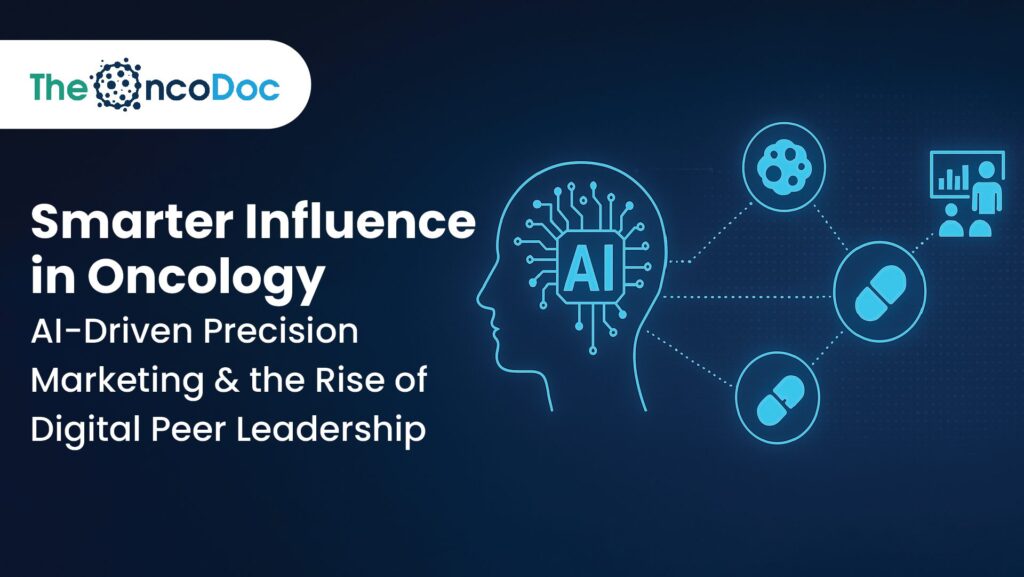Introduction: A New Era of Influence in Oncology Pharma
The traditional model of healthcare marketing, reliant on brand push, KOL endorsement, and high-frequency rep visits, is quickly giving way to something more precise, personalized, and powerful. In oncology, where the pace of discovery and the burden of complexity are unmatched, marketers must rethink how they reach, educate, and engage clinicians.
The shift is not simply digital: it is intelligent and ethical, powered by AI technologies, behavioral insights, and micro-influencer networks of credible, peer-trusted oncologists. This article explores how pharmaceutical marketers can move from campaigns to ecosystems, building trust, clinical value, and long-term brand equity through smarter, AI-augmented engagement.
1. From Reach to Resonance: The Influence Equation Is Changing
Influence in oncology is no longer measured in podium presence or publication count alone. Today’s most impactful HCP voices are digital-first, data-driven, and community-grounded.
These new influencers:
- Share practical, case-based content on platforms like LinkedIn or WhatsApp
- Speak in local languages with contextual knowledge of patient demographics
- Facilitate rather than dominate conversations, generating peer-to-peer learning
Instead of broadcasting to thousands, these “peer leaders” engage hundreds with purpose, and it is this specificity that pharma must now embrace.
2. Role of AI in Identifying and Mapping Oncology Micro-Influencers
Artificial intelligence has transformed how we find and understand influence. Using natural language processing (NLP), machine learning algorithms can now:
- Detect high-engagement HCP voices across digital channels
- Cluster influencers by subspecialty (e.g., hemato-oncology, rare tumors)
- Score content quality, sentiment, and professional tone
- Predict audience overlap, channel preferences, and educational value
This allows marketers to build dynamic influence maps, identifying not only who the influencers are but also how, when, and where they should be activated.
3. Personalization at Scale: Precision Outreach in Practice
Once influencers are identified, AI tools can create hyper-relevant journeys through
- Behavioral profiling: When, where, and how HCPs consume information
- Content performance metrics: Dwell time, bounce rates, scroll depth
- Trigger-based automation: Follow-ups post-conference, CME, or peer comments
For instance:
- An HCP engaging with immunotherapy toxicity content may be sent an explainer video on steroid protocols
- A regional DOL in Eastern India may receive access to patient journey maps in Bengali for social sharing
AI-generated behaviour signals used to trigger oncology content personalisation
4. Ethics by Design: Ensuring Compliance in AI-Driven Micro-Influence
Ethical pharma marketing is not a constraint; it’s a competitive advantage. With AI, marketers must implement compliance-by-design, ensuring:
- All influencer activity is transparent and opt-in
- AI content generation uses MLR-approved sources only
- Influencer independence and clinical neutrality are protected
Survey of compliance and medical affairs leaders across Indian and global pharma teams (2024)
5. Strategic Use of Platforms: Matching Channel to Clinical Behavior
Not all platforms are created equal. Micro-influencers in oncology use platforms with precision:
- LinkedIn: Best for research translation, peer discussions, and journal club threads
- YouTube & Instagram Reels: Great for case summaries and visual explainers
- Telegram & WhatsApp: For referral guidance and regional CME invitations
- Twitter/X: Real-time updates during oncology congresses and data releases
Marketers must tailor content to the platform, using AI tools to automate resizing, summarization, and localization.
6. The Rise of Interactive Micro-Content in Oncology Education
Static formats are losing traction. Oncology micro-influencers increasingly favor interactive and visual-first content, such as
- Poll-based clinical decision modules
- Animated dose adjustment flows
- Multi-slide case carousels with embedded resources
- Language-personalized survival curve interpretations
These assets are often co-developed between influencers and pharma, ensuring both scientific accuracy and peer relatability.
7. Measuring What Matters: Moving Beyond Vanity Metrics
Legacy marketing metrics like impressions or likes are increasingly irrelevant in oncology. Instead, marketers are prioritizing KPIs tied to
- Script initiation
- Peer engagement quality
- Portal revisit behavior
- CME influence and conversion
Metrics reported across 14 oncology brands in APAC/EMEA markets
8. Deep Local Integration: Hyper-Regional Digital Strategy
The Indian oncology landscape is diverse, decentralized, and linguistically complex. AI-enabled micro-influencer programs must be
- Localized in voice and channel (e.g., voice notes in Kannada, memes in Marathi)
- Mapped to regional screening and treatment disparities
- Aligned with government initiatives like Ayushman Bharat and state NCD programs
Tapping into local influencers helps pharma reach primary care physicians, gynecologists, dentists, and pathologists, many of whom are the first point of contact in the cancer journey.
9. Empowering Influencers with Tools, Not Just Contracts
True partnership means enabling influencers to lead. Offer them:
- Access to real-world data dashboards (via MSL collaboration)
- Early access to post-congress summaries or expert panels
- Co-branded CME series with neutral, educational positioning
- Modular toolkits: pre-approved slides, infographics, regional factsheets
This positions the pharma brand not as a sponsor, but as an enabler of knowledge exchange.
10. Content Innovation in Action: Modular Frameworks for Scalable Influence
As the pace of oncology innovation increases, pharma brands must become not only distributors of education but architects of modular content ecosystems. Influencers, particularly in regional markets, need adaptable tools they can personalize without violating regulatory guardrails.
What defines effective modular content for micro-influencers?
- Pre-approved content blocks: e.g., trial visuals, MOA animations, infographic templates
- Localization-ready assets: Language layers and regional epidemiology stats built-in
- Flexible form factors: Carousels for LinkedIn, reels for Instagram, slides for WhatsApp
- AI-assisted personalization: Content recommendations that auto-adjust based on the influencer’s specialty and past performance
This system turns influencers from passive promoters into active scientific translators, connecting brand science with local peer relevance.
11. Influencer Enablement: Training, Toolkits, and Autonomy
Pharma brands often under-invest in influencer readiness. A well-structured AI-driven influencer program must not only activate credible voices but also empower them with confidence and compliance.
Three core pillars of enablement:
- Scientific fluency:
- Regular virtual workshops co-hosted by MSLs and clinical experts
- Real-world clinical problem-solving sessions (e.g., “How to explain molecular testing in regional practice”)
- Digital mastery:
- Social media etiquette + platform optimization
- Editing tools, captioning aids, and mobile-first design kits
- Compliance literacy:
- Clear do’s and don’ts, with examples
- MLR-compliant posting templates with AI support
Brands that support influencers, not just sponsor them, see higher retention, higher content reuse, and stronger peer respect.
12. Channel Optimization: Platform Choice and Message Crafting
Each channel has its native tone, algorithm, and behavior cycle. Micro-influencers must be coached, and AI can assist in aligning message format to the ecosystem.
| Platform | Best For | Tone |
| Journal clubs, thought leadership | Professional, case-heavy | |
| Patient journeys, awareness, reels | Empathetic, visual | |
| CME distribution, Q&A threads | Informal, referral-focused | |
| Telegram | Regional group moderation, diagnostics | Technical, fast-moving |
| YouTube | Tumor board recaps, interviews | Detailed, educational |
| ResearchGate | Publication commentary, data drops | Academic, evidence-led |
AI-powered insight engines can guide influencers on where and when to post what, based on target audience dwell time, content fatigue markers, and local performance trends.
13. Multilingual Strategy and Vernacular Expansion
English-only messaging will not suffice in a country where 88% of patients and many frontline doctors rely on native languages for clinical understanding. AI-driven NLP and translation systems now make it feasible to scale micro-influence across India’s linguistic spectrum.
Strategic Components:
- Voiceover libraries in Hindi, Tamil, Telugu, Bengali, and Marathi
- Captioning AI that preserves tone and nuance in clinical explanations
- Geo-local video CMS that triggers regional updates to local influencer groups
- Multilingual CME platforms integrated with WhatsApp bots for access
The benefit isn’t just broader reach; it’s deeper comprehension and stronger emotional connection, especially in sensitive cancers like cervical, head-and-neck, and GI malignancies.
14. Behavioral Science + Influence: The Psychology of Message Retention
AI personalization becomes more powerful when guided by behavioral science. Oncology messaging, especially around complex trials or rare pathways, benefits from cognitive scaffolding, a structure that makes information easier to digest and act upon.
Techniques that improve influence outcomes:
- Pre-commitment nudges: “Click here if you want to be reminded of HER2-low case tips tomorrow.”
- Choice architecture: Framing therapy comparisons with subtle emphasis on guidelines
- Reciprocity loops: Offering free CME micro-certifications in return for peer sharing
- Anchoring: Leading with familiar data before introducing new pathways
When micro-influencers apply these in their storytelling, they shift from informers to behavioral nudgers.
15. Risk Scenarios and Mitigation Frameworks in Influencer Campaigns
With great reach comes great risk. AI-backed influencer programs in pharma, especially in high-regulation environments like oncology, must have built-in mitigation systems.
| Risk Type | Recommended AI-Led Mitigation |
| Off-label interpretation | Real-time NLP monitoring with red flag tagging |
| Inconsistent message sequences | AI-driven content path audits |
| Biased HCP targeting | Periodic fairness reviews in training data |
| Non-compliant reshares | Platform-integrated traceable watermarking |
| Over-automation of messaging | Hybrid review triggers based on threshold variance |
Compliance should be proactive, not reactive. Every influencer post can be reviewed by AI for deviation before triggering human escalation.
16. Case Study: Precision DOL Strategy for Ovarian Cancer Early Diagnosis
Background:
A mid-sized pharma firm was preparing to launch a diagnostic education campaign for HRD testing in recurrent ovarian cancer. Despite promising new therapies, testing rates were under 30%, especially outside metros.
Objective:
Improve awareness and adoption of HRD testing protocols through micro-influencer education, targeting gynecologic oncologists and diagnostic pathologists in tier 2 cities.
Approach:
- AI Mapping: Identified 60 HCPs with regional influence based on CME comments, referral volumes, and vernacular blog posts.
- Toolkit: Influencer packs included animated gene-pathway videos, CME modules, and WhatsApp-ready flowcharts.
- Engagement Strategy:
- Bilingual Telegram channels moderated by influencers
- AI-personalized reminder nudges post-DOL video view
- CME pre-quiz tailored by previous user behavior
Results (90 Days Post-Campaign):
- 41% increase in HRD test orders in 10 districts
- 24% increase in CME certification completions
- 3.2x higher HCP engagement rate compared to static KOL-only formats
- 15-point increase in influencer favorability score among participating HCPs
Takeaway:
Micro-influencers, when activated intelligently and supported ethically, can change clinical behavior faster than top-down messaging.
17. Case Study: AI-Powered DOL Network for Rare Oncology Education
Challenge: A global pharma company launched a therapy targeting MET exon 14 skipping in NSCLC, a rare indication with low testing rates in India.
Strategy:
- AI identified 50 pathologists and oncologists active on digital forums
- The influencer toolkit included video abstracts, mutation report guides, and lab-to-treatment workflows
- WhatsApp CME clusters were moderated by micro-influencers in 6 languages
Outcomes:
- 47% increase in mutation testing within 90 days
- +28% webinar registration vs. KOL-only model
- +12% brand favorability among non-target HCPs exposed to the campaign
18. Preparing for the Future: AI-Augmented Scientific Communities
Looking ahead, the micro-influencer ecosystem will move toward AI-powered, self-sustaining knowledge collectives.
- Dynamic peer circles formed based on clinical interest and digital behavior
- AI-moderated tumor boards recommending discussion topics based on ongoing trials
- Smart content agents that push data updates to influencers’ dashboards pre-conference
- Virtual avatars for CME review and interactive decision-making simulations
These aren’t fantasy; they’re already in pilot across global oncology education platforms. The pharma brand that becomes a facilitator of these learning loops will lead not just in influence but in innovation trust.
Conclusion: Redefining Influence in Oncology with Intelligence and Integrity
The future of oncology pharma marketing lies not in saturation, but in precision, partnership, and presence. Micro-influencers, when paired with AI-powered platforms, offer an unprecedented opportunity to engage oncologists in clinically relevant, emotionally resonant, and ethically aligned ways.
By reimagining content creation, platform activation, and performance measurement through a digital-first lens, pharma brands can elevate their role from industry voice to trusted clinical partner.
Influence is no longer about reach; it’s about resonance. And in oncology, that resonance saves lives.
The Oncodoc team is a group of passionate healthcare and marketing professionals dedicated to delivering accurate, engaging, and impactful content. With expertise across medical research, digital strategy, and clinical communication, the team focuses on empowering healthcare professionals and patients alike. Through evidence-based insights and innovative storytelling, Hidoc aims to bridge the gap between medicine and digital engagement, promoting wellness and informed decision-making.



